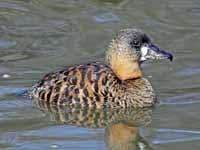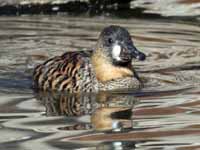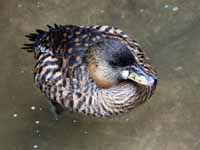The term waterfowl is used to describe any member of the order Anseriformes. A series of articles describes all the waterfowl. This specific article describes the "whistling ducks " which belong to family Anatidae, subfamily Dendrocygninae.
Anseriformes
Most species of the order Anseriformes spend a considerable amount of time in water. In fact, they are called waterfowls. Their webbed feet make for efficient swimming. A few species spend little time in water and thus their feet are only partially webbed. Most waterfowl are also good flyers, many migrating long distances to escape the cold and others migrating shorter distances for optimizing their food supply. All species, except the screamers, have a wide and relatively flat bill. The shape of a species bill and also their tongue is a function of their diet. Considering the entire order, they eat aquatic plants, grasses, sedges, algae, plankton, insects, insect larvae, mollusks, crustaceans, fish, fruits, grains, rice. Most species are monogamous and if they lose a partner seem to mourn. Males are larger and heavier than females. The chicks are well developed when they hatch and can walk almost immediately.
The order Anseriformes has 3 familes: Anatidae, Anhimidae, Anseranatidae. Family Anatidae is comprised of the ducks, swans, and geese which amounts to about 160 species. Family Anhimidae is made up of 3 screamer species while family Anseranatidae has only one species, the magpie goose. Since these latter two families contain so few species, it seems appropriate to consider the entire order in this series of articles.
Anatidae
The Anatidae family has the following subfamiles:
Anatinae: dabbling ducks and teals
Anserinae: geese, swans
Aythyinae: diving ducks
Dendrocygninae: whistling ducks
Merginae: sea-ducks
Oxyurinae: stiff-tailed ducks
Plectropterinae: spur-winged goose
Stictonettinae: freckled duck
Tadorninae: shelducks, shelgeese
Whistling Ducks
The whistling-ducks have a loud whistling-like call, which explains their name. They are treated here as having their own Anatidae subfamily - Dendrocygninae. Some place the whistling ducks in their own Dendrocygnidae, but that placement is not accepted by many.
Whistling-ducks have long legs and necks, and are very gregarious, flying to and from night-time roosts in large flocks. Both sexes have the same plumage, thus they are not truly dimorphic. However, the male whistling duck average larger than the female. Whistling ducks usually have black on their under-wings. They live mainly near freshwater, but some can be found at saline estuaries and mangroves. Their preferred foraging methods in the water are wading or diving, but dabbling occurs too. Whistling ducks are mainly vegetarian eating aquatic vegetation, grasses, rice. Some do eat small fish, frogs, mollusks, crustaceans, and worms. Nests are constructed in a variety of places depending on the species: hollow trees, unused tree-nests of other species, wetlands, and fields. Since many do nest in trees and most roost in trees, the whistling-ducks have also been called tree-ducks, but that terminogy seems to be falling into disuse. They live in temperate or tropical regions. Most of the species do not migrate, but do move during dry spells.
Genus Dendrocygna
Duck, Black-bellied Whistling- Dendrocygna autumnalis
Description: The black-bellied whistling-duck has a chestnut brown back, crown, lower neck, and breast. The head, face, and upper neck are pale grey. It has a black belly and tail, long red bill, and white eye-ring. There is extensive white on the under-wing. Juveniles are similar but have a grey bill and less contrasting belly. Only the most northern birds migrate.
Range: The Americas (southernmost United States, Mexico, and tropical Central to south-central South America.)
Habitat: Freshwater wetlands with emergent vegetation. Also likes to swim in open water.
Diet: Mainly vegetarian: seeds, grasses, grains. Also some insects, mollusks. Feeds on shore or in shallow water.
Conservation status: Least Concern.
Image by:
1, 2, 3)
Dick - Sylvan
Heights 4) Alan D. Wilson Range: The Americas (southernmost United States, Mexico, and tropical Central to south-central South America.)
Habitat: Freshwater wetlands with emergent vegetation. Also likes to swim in open water.
Diet: Mainly vegetarian: seeds, grasses, grains. Also some insects, mollusks. Feeds on shore or in shallow water.
Conservation status: Least Concern.
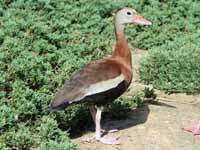



Duck, Fulvous Whistling- Dendrocygna bicolor
Description: The fulvous whistling-duck has a brownish-yellow (fulvous) head, neck, and breast. There is a pale rough patch of feathers on the neck and a dark stripe down center of the nape. The back is dark colored with rufous edgings on the mantle and reddish-tinge on the flanks. It has a creamy white upper-tail. The bill is grey, The similar lesser whistling-duck does not have a dark line down center of nape. It is also similar to the wandering whistling-duck, but their ranges do not overlap. Only the most northern birds migrate.
Range: The Americas, Africa, south Asia.
Habitat: Freshwater or brackish shallow waterbodies such as marshes and swamps. Also rice fields.
Diet: Seeds and other parts of aquatic plants. Also eats rice from the fields.
Conservation status: Least Concern.
Image by: 1) David_Alvarez_Lopez 2) Peter_Potrowl 3) Felix_Uribe Range: The Americas, Africa, south Asia.
Habitat: Freshwater or brackish shallow waterbodies such as marshes and swamps. Also rice fields.
Diet: Seeds and other parts of aquatic plants. Also eats rice from the fields.
Conservation status: Least Concern.
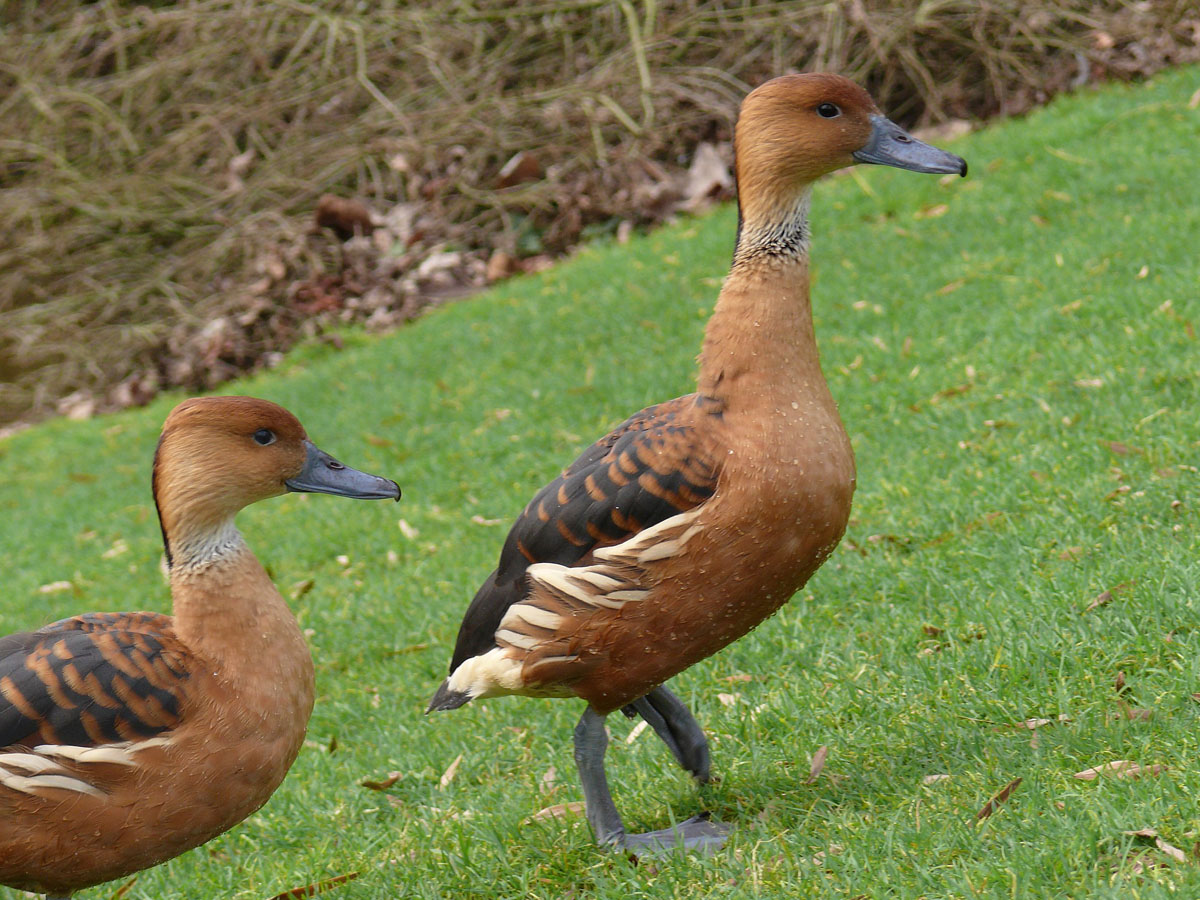
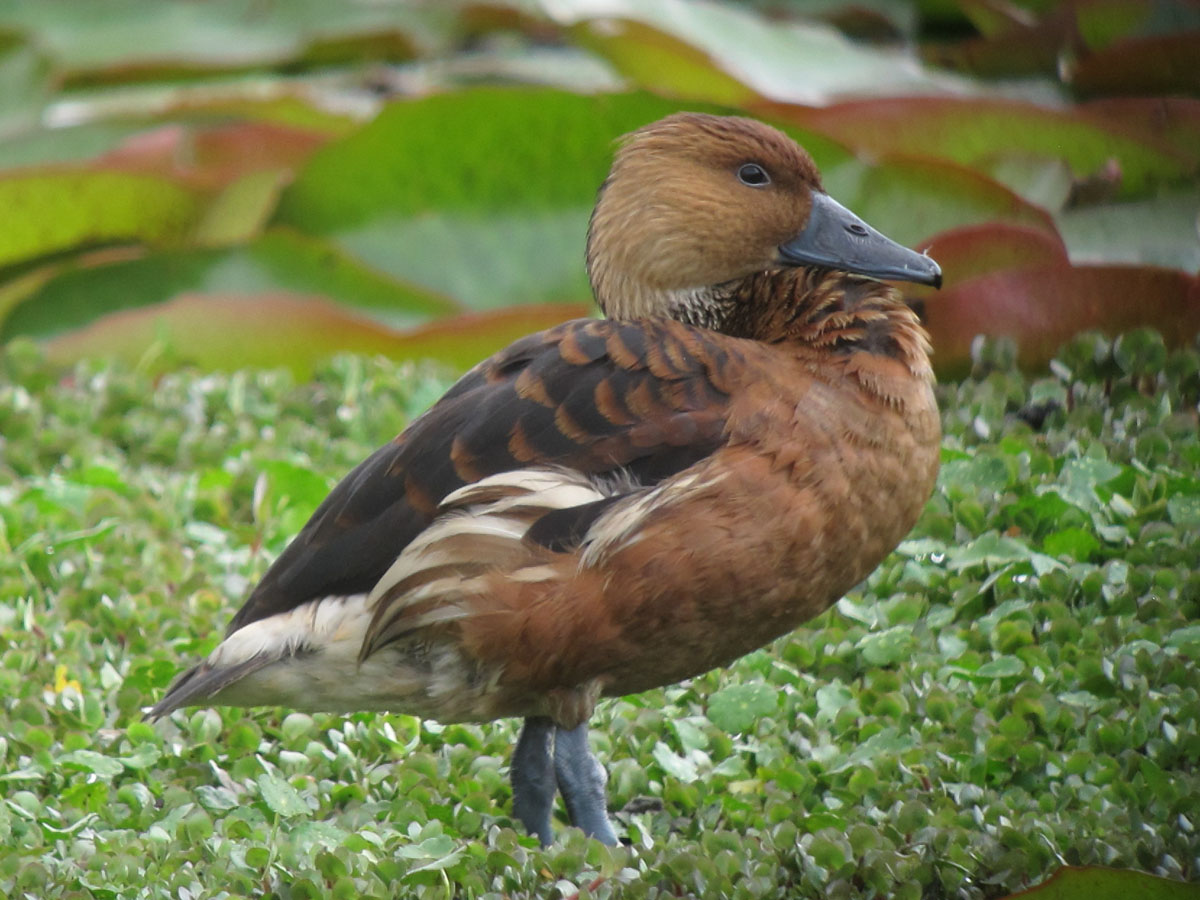
Duck, Lesser Whistling- Dendrocygna javanica
Description: The lesser whistling-duck, also known as the Indian whistling-duck, has a dark back with paler fringing. It has a chestnut white upper-tail. There is a yellow eye-ring, which is often pale. Compared to the fulvous whistling-duck it has these differences: the yellow-eye ring, chestnut instead of creamy upper-tail, and no pale rough patch of feathers on the neck coverts. Only the most northern birds migrate.
Range: Indian subcontinent, southeast Asia.
Habitat: Freshwater wetlands with good vegetation cover. Often rest during the day on the wetland banks or on the open sea in coastal areas.
Diet: Mainly aquatic plants. Also rice, small fish, frogs, mollusks, worms. It dives and also dabbles for food.
Conservation status: Least Concern.
Image by: 1) Thimindu - Sri Lanka 2) Fiorellino - Walsrode Bird Park, Germany 3) Dick Daniels - Sylvan Heights
4) Gaurika Wijeratne - Sri LankaRange: Indian subcontinent, southeast Asia.
Habitat: Freshwater wetlands with good vegetation cover. Often rest during the day on the wetland banks or on the open sea in coastal areas.
Diet: Mainly aquatic plants. Also rice, small fish, frogs, mollusks, worms. It dives and also dabbles for food.
Conservation status: Least Concern.


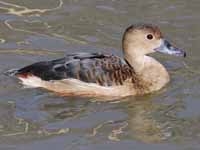
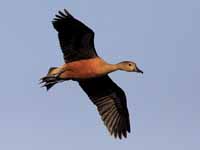
Duck, Plumed Whistling- Dendrocygna eytoni
Description: The plumed whistling-duck has long plumes emanating from the reddish-tinged flanks. The upperparts are dark greyish-brown and the breast is chestnut with dark bars. The head and belly are buff, the bill is dark grey.
Range: Australasia.
Habitat: Tall grassland and savanna, often near bodies of water.
Diet: Grasses, rice, aquatic seeds, snails, fish, worms.
Conservation status: Least Concern.
Image by: 1) Arthur Chapman - Queensland 2) Helen - Perth 3) Glen Fergus - Queensland 4) JJ Harrison - New South WalesRange: Australasia.
Habitat: Tall grassland and savanna, often near bodies of water.
Diet: Grasses, rice, aquatic seeds, snails, fish, worms.
Conservation status: Least Concern.

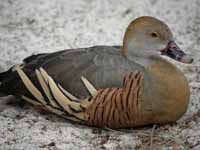
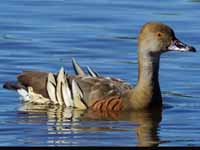

Duck,_Spotted_Whistling- Dendrocygna guttata
Description: The spotted whistling-duck has a dark brown back, crown, breast and wings. There are white spots on underparts underparts, a light grey face, and a black bill.
Range: Philippines, Australasia.
Habitat: Wetlands with nearby grasses and some trees.
Diet: Terrestrial and aquatic plants, snails. Forages on wetlands by dabbling and diving.
Conservation status: Least Concern.
Image by: 1) Tony_Morris 2, 3) Dick Daniels - Sylvan Heights 4) Aviceda - QueenslandRange: Philippines, Australasia.
Habitat: Wetlands with nearby grasses and some trees.
Diet: Terrestrial and aquatic plants, snails. Forages on wetlands by dabbling and diving.
Conservation status: Least Concern.

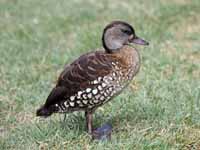
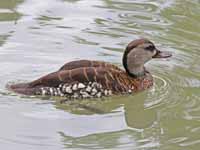

Duck, Wandering Whistling- Dendrocygna arcuata
Description: The wandering whistling-duck has dark upperparts with yellowish edgings. It has a dark crown, and dark median stripe along the nape. The under-wings and bill are black. Some have a pale throat while others have a more patterned throat. The breast is reddish-brown with black spotting. The belly and flanks are chestnut with pale plumes on the flanks. It is closely related to the fulvous whistling-duck, but their ranges do not overlap.
Range: Philippines to Indonesia, Australasia.
Habitat: Waterbodies that are rather deep. They do not stray far from water.
Diet: Aquatic plants and grasses; mainly vegetarian. Forage mainly by diving; dabbles some.
Conservation status: Least Concern.
Image by: 1) Jim_Bendon 2) Jerry Oldenettel - Papua New Guinea 3) Brian Gratwicke 4) JJ_HarrisonRange: Philippines to Indonesia, Australasia.
Habitat: Waterbodies that are rather deep. They do not stray far from water.
Diet: Aquatic plants and grasses; mainly vegetarian. Forage mainly by diving; dabbles some.
Conservation status: Least Concern.
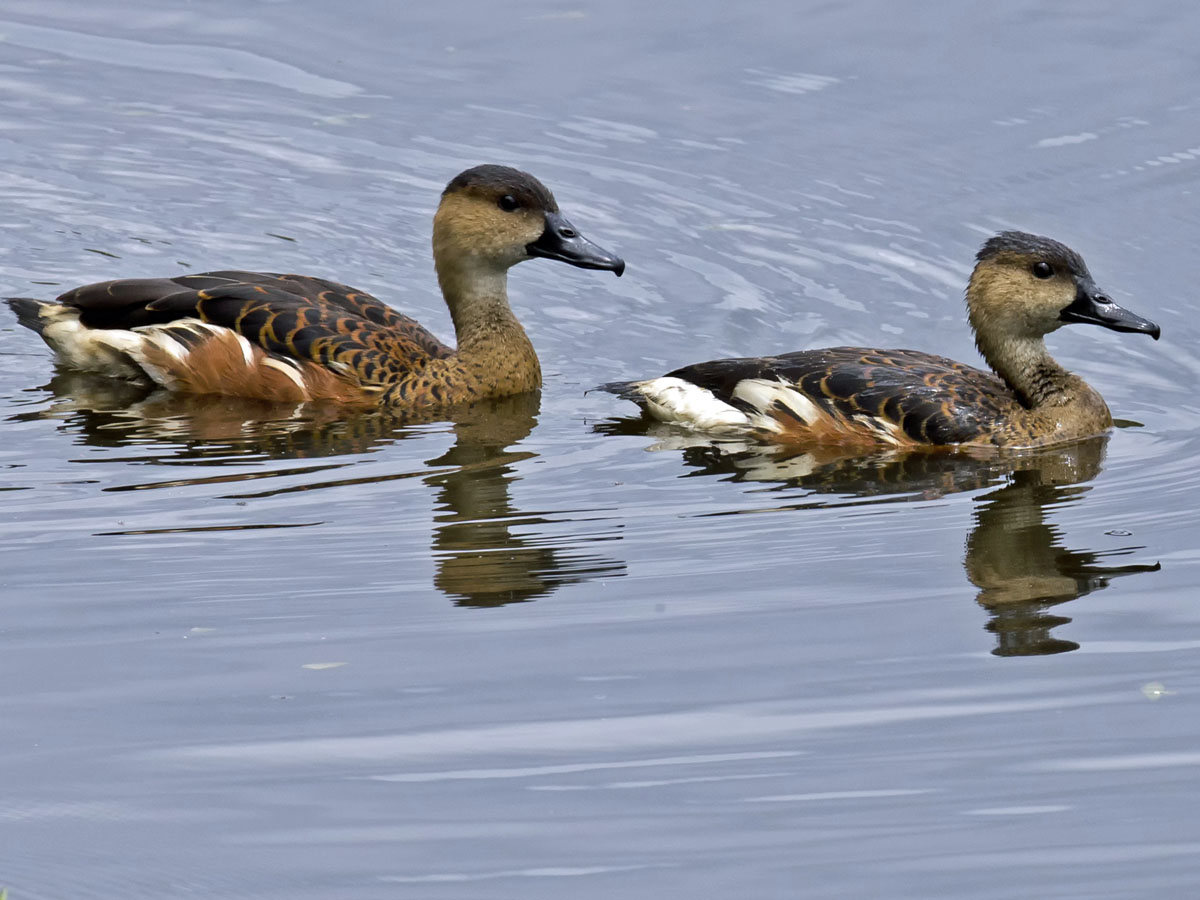
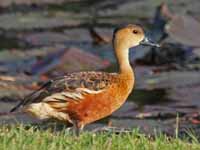
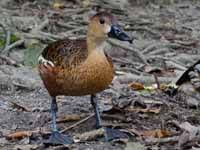
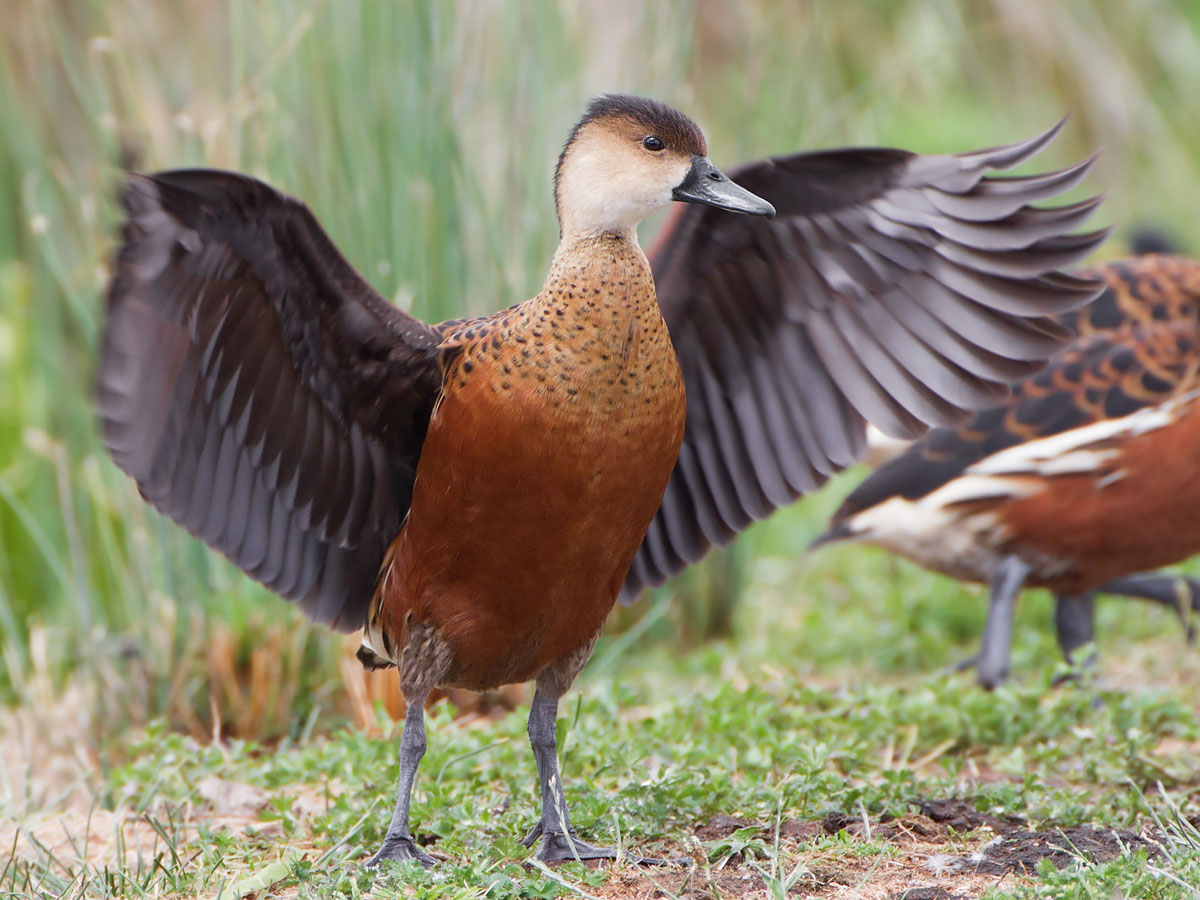
Duck, West Indian Whistling- Dendrocygna arborea
Description: The West Indian whistling-duck has dark brown upperparts with pale edges to the mantle feathers. The crown is brown, breast reddish-brown, bill black, plus the face and neck are pale. It is the only whistling-duck in the Americas that has white spots on its belly.
Range: The Caribbean.
Habitat: Swamps, mangroves, and other freshwater or saline wetlands with tree cover.
Diet: Fruit of the royal palm, various crops (therefore considered by some to be a nuisance), Does not dive, but does dabble.
Conservation status:The West Indian whistling-duck is Near Threatened due to hunting, invasive animals such as feral cats and mongoose, wetland distruction.
Image by:
1, 2, 3, 4) Dick - Sylvan Heights Range: The Caribbean.
Habitat: Swamps, mangroves, and other freshwater or saline wetlands with tree cover.
Diet: Fruit of the royal palm, various crops (therefore considered by some to be a nuisance), Does not dive, but does dabble.
Conservation status:The West Indian whistling-duck is Near Threatened due to hunting, invasive animals such as feral cats and mongoose, wetland distruction.

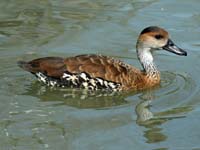

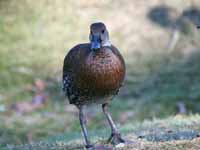
Duck, White-faced Whistling- Dendrocygna viduata
Description: The white-faced whistling-duck has a distinctive head with white on the front and black on the rear. The bill is black. It has a brown mantle which fades to near black at the tail. The breast is dark brown and belly is white with heavy dark barring.
Range: Costa Rica to Brazil, Africa.
Habitat: Freshwater lakes or reservoirs with plentiful vegetation. rice fields.
Diet: Grasses. rice, aquatic vegetation, insects, mollusks, crustaceans. Forages by grazing and diving. Sometimes dabbles.
Conservation status: Least Concern.
1) Bernard_Dupont - South Africa 2. 3) Dick - Birds of Eden, South Africa 4) Dick Daniels - Sylvan Heights
Range: Costa Rica to Brazil, Africa.
Habitat: Freshwater lakes or reservoirs with plentiful vegetation. rice fields.
Diet: Grasses. rice, aquatic vegetation, insects, mollusks, crustaceans. Forages by grazing and diving. Sometimes dabbles.
Conservation status: Least Concern.


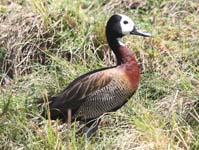
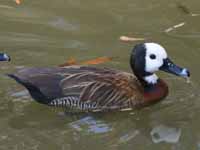
Genus Thalassornis - 1 species
It is not clear what the nearest relative is of the White-backed Duck, perhaps the whistling-ducks. They do have a call similar to whistling-ducks.
Duck, White-backed Thalassornis leuconotus
Description: The white-backed duck's name is a misnomer - the white is only seen in flight and it does not fly very much! It has a dark forehead and mask plus a distinctive white loral patch. Most of the plumage is mottled and the neck is pink.
Range: Sub-Saharan Africa.
Habitat: Lakes, ponds, swamps and marshes.
Diet: Bulbs of waterlilies, but also their seeds and leaves. Also other aquatic vegetations.Young also feed on insect larvae.
Conservation status: Least Concern.
Image by: 1, 2, 3) Dick Daniels- Sylvan Heights 4) Dick - San Diego ZooRange: Sub-Saharan Africa.
Habitat: Lakes, ponds, swamps and marshes.
Diet: Bulbs of waterlilies, but also their seeds and leaves. Also other aquatic vegetations.Young also feed on insect larvae.
Conservation status: Least Concern.

